Marketing Plan and Strategy Analysis: Digi Telecommunications Berhad
VerifiedAdded on 2023/06/10
|29
|6692
|371
Report
AI Summary
This report presents a detailed marketing plan for Digi Telecommunications Berhad, a major telecommunications provider in Malaysia. The analysis begins with an introduction to the company and its market position, followed by a comprehensive situation analysis, including macro and microenvironmental factors such as political, economic, social, technological, legal, and environmental aspects, as well as Porter's Five Forces. The report then delves into Digi's internal environment, including its mission, vision, culture, and strategy, using the McKinsey 7S framework and SWOT and TOWS analyses. The marketing strategies and objectives are outlined, including the Ansoff Matrix and market development and penetration strategies. Segmentation, targeting, and positioning are discussed, along with a detailed marketing program utilizing the 7Ps of the marketing mix. Finally, the report covers control and evaluation methods, including a SMART matrix and contingency planning, concluding with a summary of the findings and recommendations.
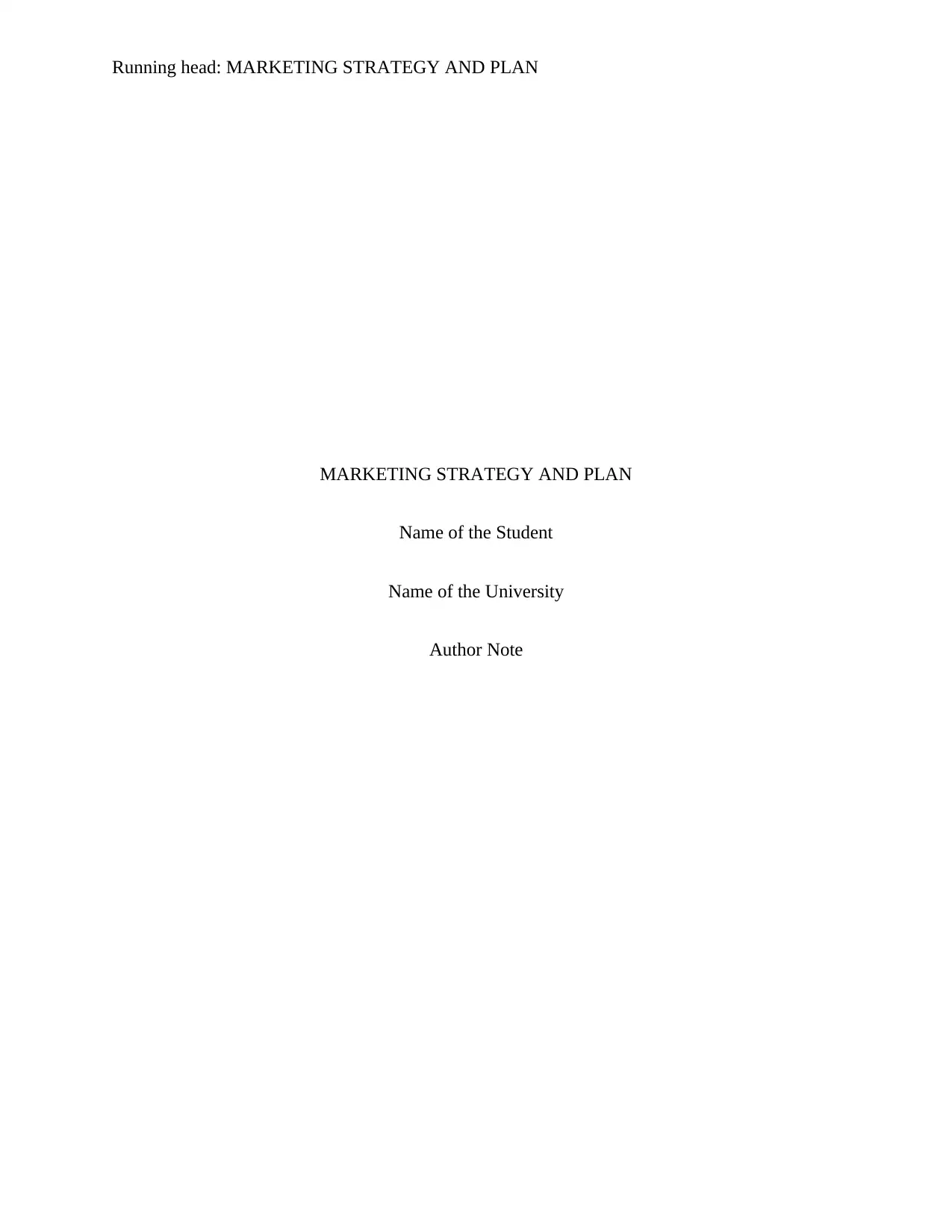
Running head: MARKETING STRATEGY AND PLAN
MARKETING STRATEGY AND PLAN
Name of the Student
Name of the University
Author Note
MARKETING STRATEGY AND PLAN
Name of the Student
Name of the University
Author Note
Paraphrase This Document
Need a fresh take? Get an instant paraphrase of this document with our AI Paraphraser
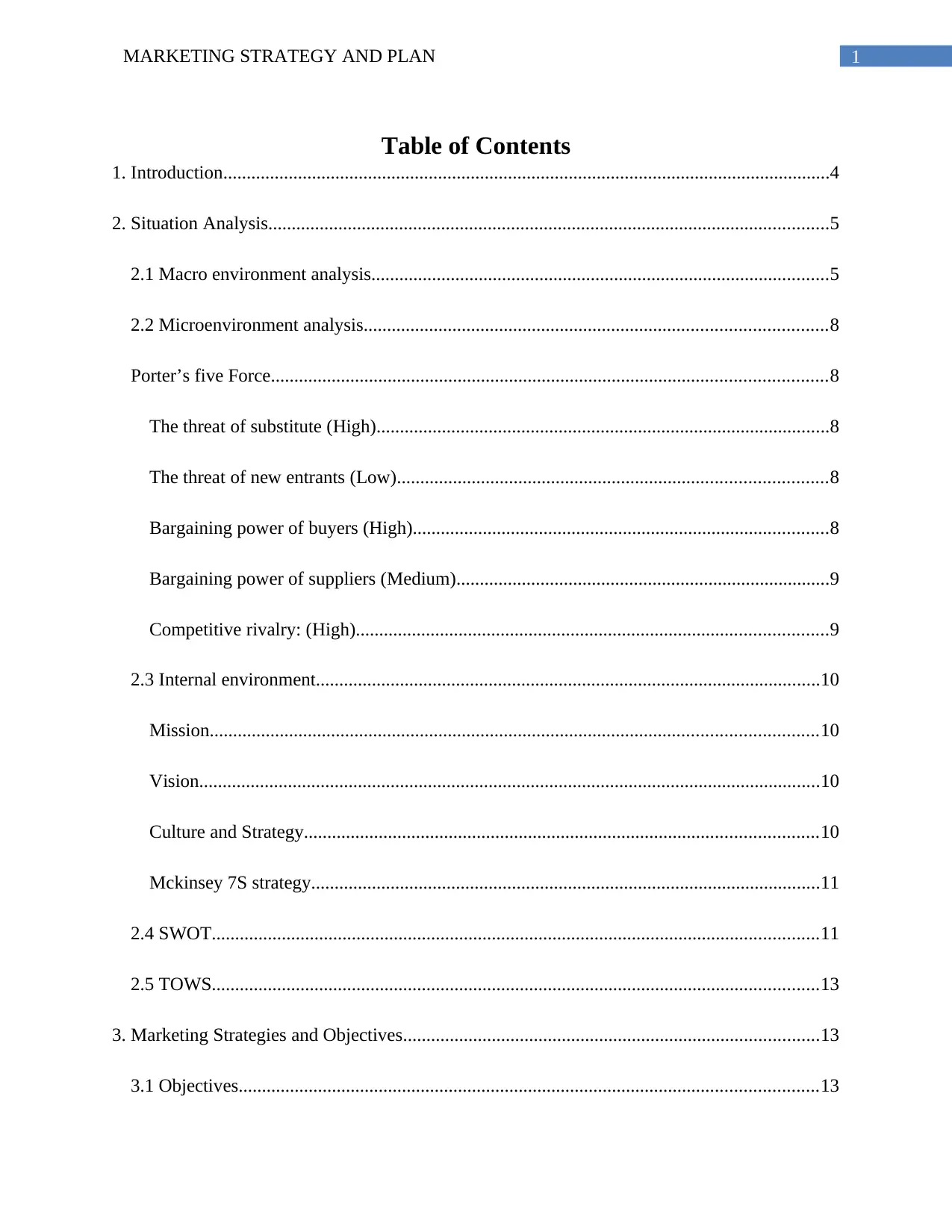
1MARKETING STRATEGY AND PLAN
Table of Contents
1. Introduction..................................................................................................................................4
2. Situation Analysis........................................................................................................................5
2.1 Macro environment analysis..................................................................................................5
2.2 Microenvironment analysis...................................................................................................8
Porter’s five Force.......................................................................................................................8
The threat of substitute (High).................................................................................................8
The threat of new entrants (Low)............................................................................................8
Bargaining power of buyers (High).........................................................................................8
Bargaining power of suppliers (Medium)................................................................................9
Competitive rivalry: (High).....................................................................................................9
2.3 Internal environment............................................................................................................10
Mission..................................................................................................................................10
Vision.....................................................................................................................................10
Culture and Strategy..............................................................................................................10
Mckinsey 7S strategy.............................................................................................................11
2.4 SWOT..................................................................................................................................11
2.5 TOWS..................................................................................................................................13
3. Marketing Strategies and Objectives.........................................................................................13
3.1 Objectives............................................................................................................................13
Table of Contents
1. Introduction..................................................................................................................................4
2. Situation Analysis........................................................................................................................5
2.1 Macro environment analysis..................................................................................................5
2.2 Microenvironment analysis...................................................................................................8
Porter’s five Force.......................................................................................................................8
The threat of substitute (High).................................................................................................8
The threat of new entrants (Low)............................................................................................8
Bargaining power of buyers (High).........................................................................................8
Bargaining power of suppliers (Medium)................................................................................9
Competitive rivalry: (High).....................................................................................................9
2.3 Internal environment............................................................................................................10
Mission..................................................................................................................................10
Vision.....................................................................................................................................10
Culture and Strategy..............................................................................................................10
Mckinsey 7S strategy.............................................................................................................11
2.4 SWOT..................................................................................................................................11
2.5 TOWS..................................................................................................................................13
3. Marketing Strategies and Objectives.........................................................................................13
3.1 Objectives............................................................................................................................13
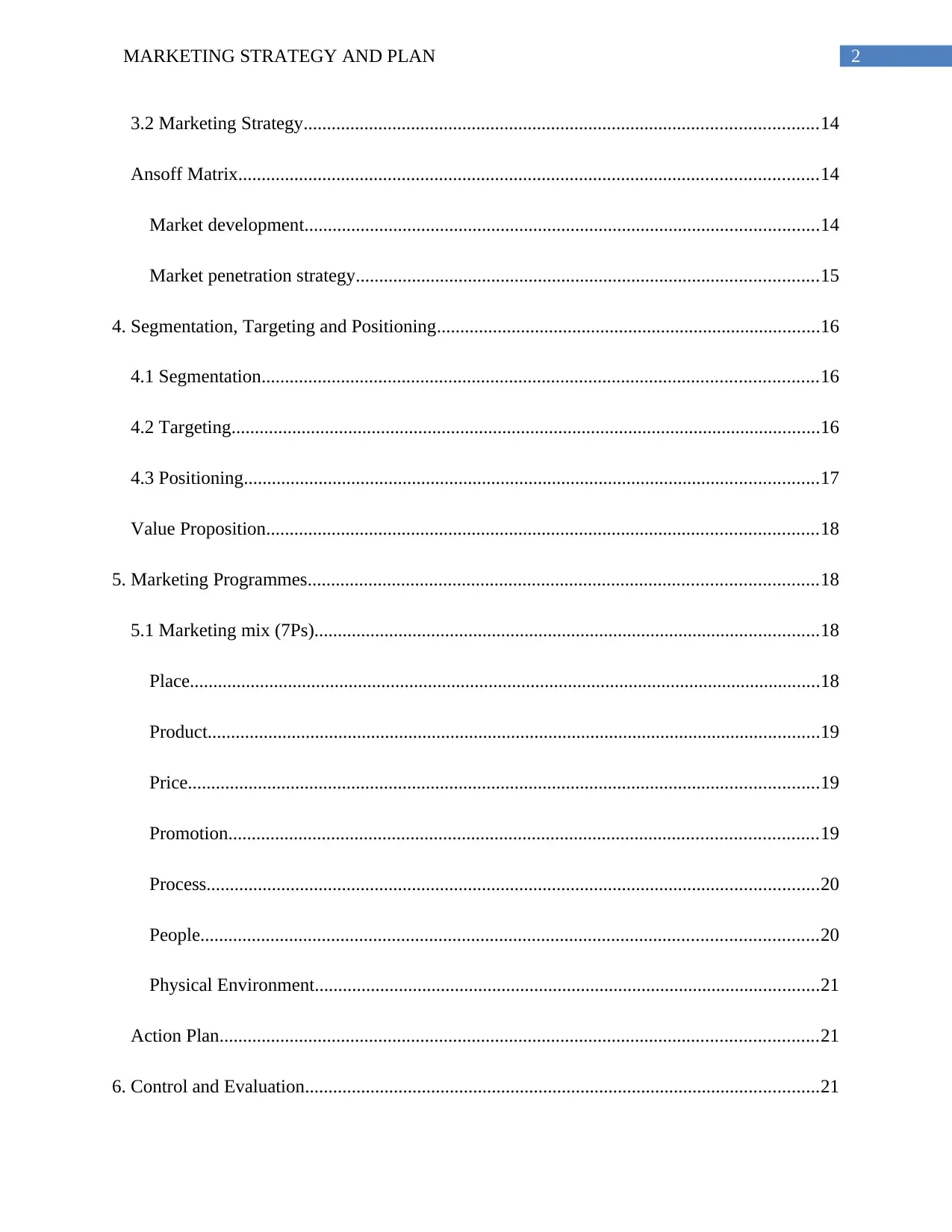
2MARKETING STRATEGY AND PLAN
3.2 Marketing Strategy..............................................................................................................14
Ansoff Matrix............................................................................................................................14
Market development..............................................................................................................14
Market penetration strategy...................................................................................................15
4. Segmentation, Targeting and Positioning..................................................................................16
4.1 Segmentation.......................................................................................................................16
4.2 Targeting..............................................................................................................................16
4.3 Positioning...........................................................................................................................17
Value Proposition......................................................................................................................18
5. Marketing Programmes.............................................................................................................18
5.1 Marketing mix (7Ps)............................................................................................................18
Place.......................................................................................................................................18
Product...................................................................................................................................19
Price.......................................................................................................................................19
Promotion..............................................................................................................................19
Process...................................................................................................................................20
People....................................................................................................................................20
Physical Environment............................................................................................................21
Action Plan................................................................................................................................21
6. Control and Evaluation..............................................................................................................21
3.2 Marketing Strategy..............................................................................................................14
Ansoff Matrix............................................................................................................................14
Market development..............................................................................................................14
Market penetration strategy...................................................................................................15
4. Segmentation, Targeting and Positioning..................................................................................16
4.1 Segmentation.......................................................................................................................16
4.2 Targeting..............................................................................................................................16
4.3 Positioning...........................................................................................................................17
Value Proposition......................................................................................................................18
5. Marketing Programmes.............................................................................................................18
5.1 Marketing mix (7Ps)............................................................................................................18
Place.......................................................................................................................................18
Product...................................................................................................................................19
Price.......................................................................................................................................19
Promotion..............................................................................................................................19
Process...................................................................................................................................20
People....................................................................................................................................20
Physical Environment............................................................................................................21
Action Plan................................................................................................................................21
6. Control and Evaluation..............................................................................................................21
⊘ This is a preview!⊘
Do you want full access?
Subscribe today to unlock all pages.

Trusted by 1+ million students worldwide
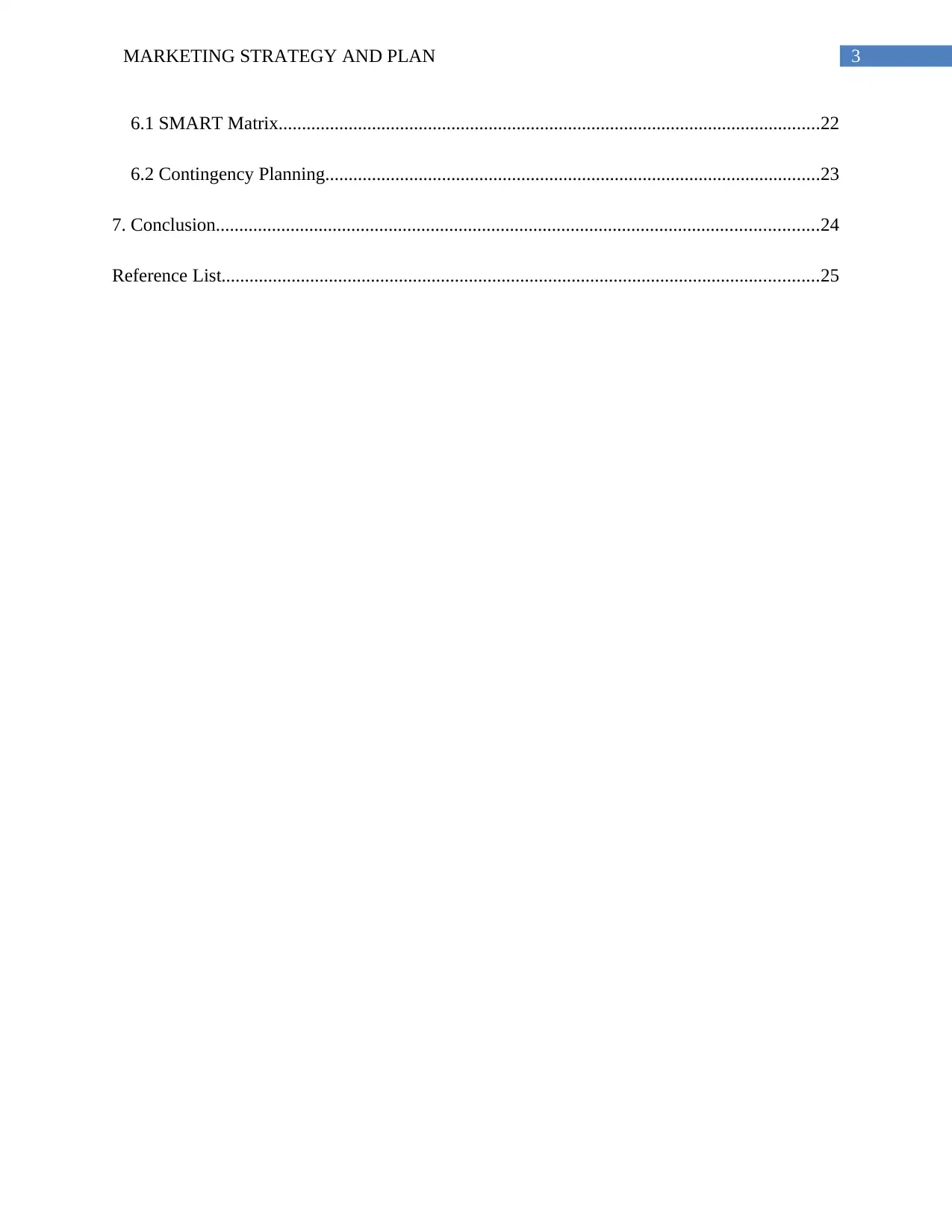
3MARKETING STRATEGY AND PLAN
6.1 SMART Matrix....................................................................................................................22
6.2 Contingency Planning..........................................................................................................23
7. Conclusion.................................................................................................................................24
Reference List................................................................................................................................25
6.1 SMART Matrix....................................................................................................................22
6.2 Contingency Planning..........................................................................................................23
7. Conclusion.................................................................................................................................24
Reference List................................................................................................................................25
Paraphrase This Document
Need a fresh take? Get an instant paraphrase of this document with our AI Paraphraser
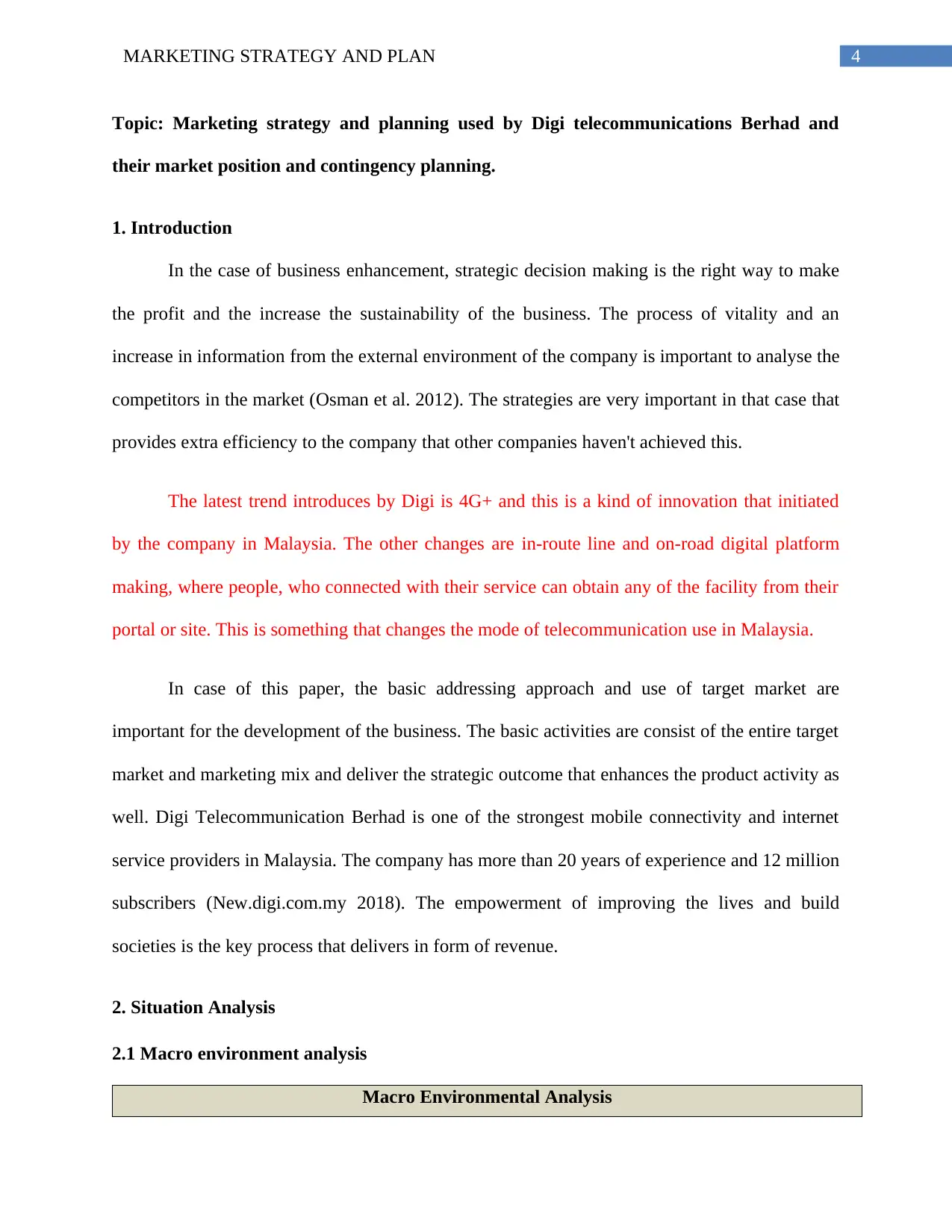
4MARKETING STRATEGY AND PLAN
Topic: Marketing strategy and planning used by Digi telecommunications Berhad and
their market position and contingency planning.
1. Introduction
In the case of business enhancement, strategic decision making is the right way to make
the profit and the increase the sustainability of the business. The process of vitality and an
increase in information from the external environment of the company is important to analyse the
competitors in the market (Osman et al. 2012). The strategies are very important in that case that
provides extra efficiency to the company that other companies haven't achieved this.
The latest trend introduces by Digi is 4G+ and this is a kind of innovation that initiated
by the company in Malaysia. The other changes are in-route line and on-road digital platform
making, where people, who connected with their service can obtain any of the facility from their
portal or site. This is something that changes the mode of telecommunication use in Malaysia.
In case of this paper, the basic addressing approach and use of target market are
important for the development of the business. The basic activities are consist of the entire target
market and marketing mix and deliver the strategic outcome that enhances the product activity as
well. Digi Telecommunication Berhad is one of the strongest mobile connectivity and internet
service providers in Malaysia. The company has more than 20 years of experience and 12 million
subscribers (New.digi.com.my 2018). The empowerment of improving the lives and build
societies is the key process that delivers in form of revenue.
2. Situation Analysis
2.1 Macro environment analysis
Macro Environmental Analysis
Topic: Marketing strategy and planning used by Digi telecommunications Berhad and
their market position and contingency planning.
1. Introduction
In the case of business enhancement, strategic decision making is the right way to make
the profit and the increase the sustainability of the business. The process of vitality and an
increase in information from the external environment of the company is important to analyse the
competitors in the market (Osman et al. 2012). The strategies are very important in that case that
provides extra efficiency to the company that other companies haven't achieved this.
The latest trend introduces by Digi is 4G+ and this is a kind of innovation that initiated
by the company in Malaysia. The other changes are in-route line and on-road digital platform
making, where people, who connected with their service can obtain any of the facility from their
portal or site. This is something that changes the mode of telecommunication use in Malaysia.
In case of this paper, the basic addressing approach and use of target market are
important for the development of the business. The basic activities are consist of the entire target
market and marketing mix and deliver the strategic outcome that enhances the product activity as
well. Digi Telecommunication Berhad is one of the strongest mobile connectivity and internet
service providers in Malaysia. The company has more than 20 years of experience and 12 million
subscribers (New.digi.com.my 2018). The empowerment of improving the lives and build
societies is the key process that delivers in form of revenue.
2. Situation Analysis
2.1 Macro environment analysis
Macro Environmental Analysis

5MARKETING STRATEGY AND PLAN
Political aspect Malaysia is one of south-east Asia's most vibrant countries and
political stability, as well as industrial growth, is the reason behind
this. In order to grow the telecommunication sector; political stability
plays an important role.
Malaysia follows the framework of the federal representative
democratic constitutional monarchy. The relationship between prime
ethics groups and the government-controlled fixed-line operator is the
main reason in that case.
In Malaysia, government-owned fixed-line operator TM (Telecom
Malaysia) rules the market in communication ad it has almost 62% of
the market share. Its subsidiary Celcom has the market share of 37%
in telephone services (Chong et al. 2016).
The active denationalisation plan in the nation helps the company in
the development of the business. Authorise equity in the business and
controlled behaviours in politics and the stable political conditions
helps the business for their sustainable condition.
Economic aspect Malaysian economy performs strongly as Malaysia has been
experienced 5.4% growth in 2018 on GDP wise. IMF stated that
Malaysia is driven by the global demand for oil and gas along with
increased labour market.
GDP of Malaysia touched $1.002 trillion and GDP per capita is
$30,558 (Tang and Tan 2015). In addition, the inflation rate is lower
by 3.8%. Moreover, this figure signifies the strong economic growth
Political aspect Malaysia is one of south-east Asia's most vibrant countries and
political stability, as well as industrial growth, is the reason behind
this. In order to grow the telecommunication sector; political stability
plays an important role.
Malaysia follows the framework of the federal representative
democratic constitutional monarchy. The relationship between prime
ethics groups and the government-controlled fixed-line operator is the
main reason in that case.
In Malaysia, government-owned fixed-line operator TM (Telecom
Malaysia) rules the market in communication ad it has almost 62% of
the market share. Its subsidiary Celcom has the market share of 37%
in telephone services (Chong et al. 2016).
The active denationalisation plan in the nation helps the company in
the development of the business. Authorise equity in the business and
controlled behaviours in politics and the stable political conditions
helps the business for their sustainable condition.
Economic aspect Malaysian economy performs strongly as Malaysia has been
experienced 5.4% growth in 2018 on GDP wise. IMF stated that
Malaysia is driven by the global demand for oil and gas along with
increased labour market.
GDP of Malaysia touched $1.002 trillion and GDP per capita is
$30,558 (Tang and Tan 2015). In addition, the inflation rate is lower
by 3.8%. Moreover, this figure signifies the strong economic growth
⊘ This is a preview!⊘
Do you want full access?
Subscribe today to unlock all pages.

Trusted by 1+ million students worldwide
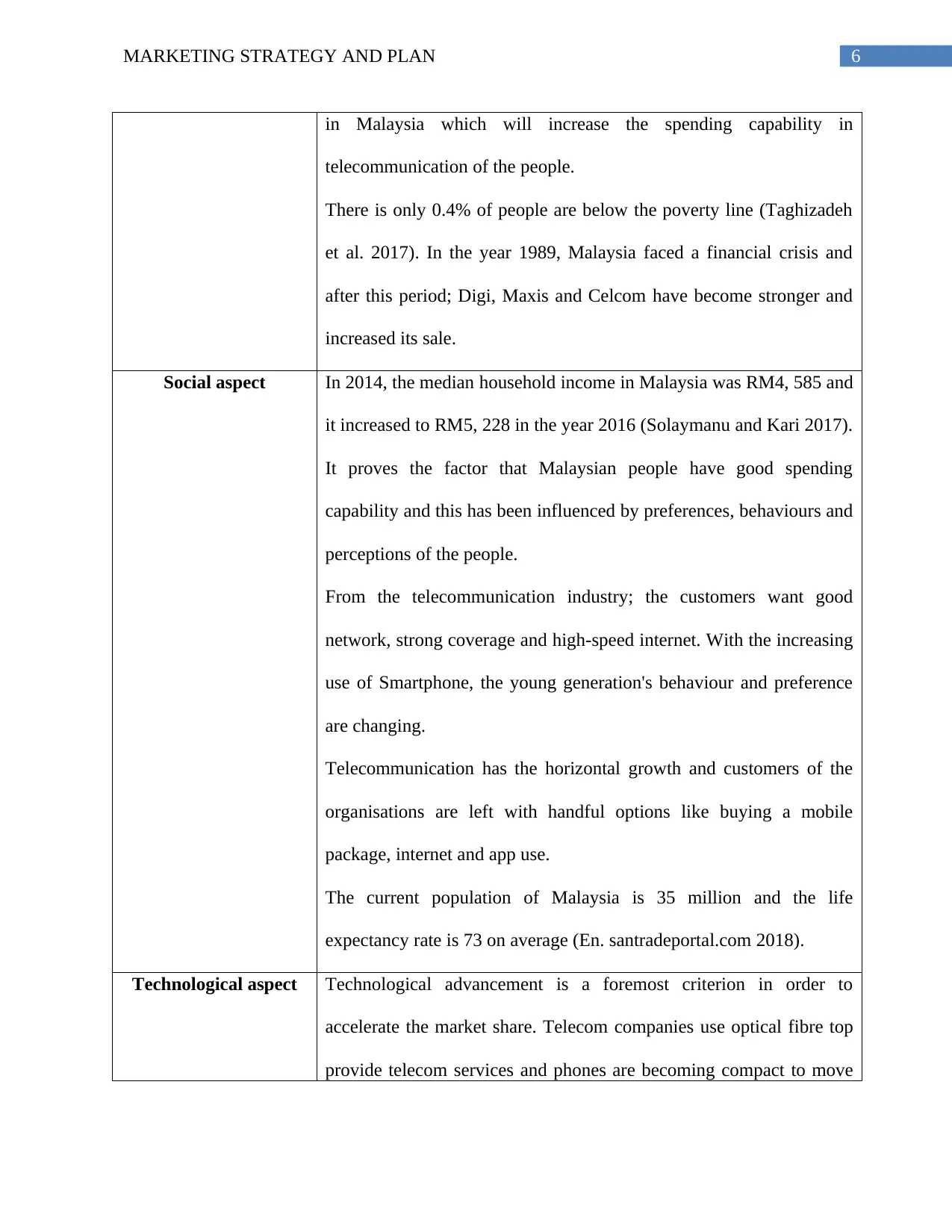
6MARKETING STRATEGY AND PLAN
in Malaysia which will increase the spending capability in
telecommunication of the people.
There is only 0.4% of people are below the poverty line (Taghizadeh
et al. 2017). In the year 1989, Malaysia faced a financial crisis and
after this period; Digi, Maxis and Celcom have become stronger and
increased its sale.
Social aspect In 2014, the median household income in Malaysia was RM4, 585 and
it increased to RM5, 228 in the year 2016 (Solaymanu and Kari 2017).
It proves the factor that Malaysian people have good spending
capability and this has been influenced by preferences, behaviours and
perceptions of the people.
From the telecommunication industry; the customers want good
network, strong coverage and high-speed internet. With the increasing
use of Smartphone, the young generation's behaviour and preference
are changing.
Telecommunication has the horizontal growth and customers of the
organisations are left with handful options like buying a mobile
package, internet and app use.
The current population of Malaysia is 35 million and the life
expectancy rate is 73 on average (En. santradeportal.com 2018).
Technological aspect Technological advancement is a foremost criterion in order to
accelerate the market share. Telecom companies use optical fibre top
provide telecom services and phones are becoming compact to move
in Malaysia which will increase the spending capability in
telecommunication of the people.
There is only 0.4% of people are below the poverty line (Taghizadeh
et al. 2017). In the year 1989, Malaysia faced a financial crisis and
after this period; Digi, Maxis and Celcom have become stronger and
increased its sale.
Social aspect In 2014, the median household income in Malaysia was RM4, 585 and
it increased to RM5, 228 in the year 2016 (Solaymanu and Kari 2017).
It proves the factor that Malaysian people have good spending
capability and this has been influenced by preferences, behaviours and
perceptions of the people.
From the telecommunication industry; the customers want good
network, strong coverage and high-speed internet. With the increasing
use of Smartphone, the young generation's behaviour and preference
are changing.
Telecommunication has the horizontal growth and customers of the
organisations are left with handful options like buying a mobile
package, internet and app use.
The current population of Malaysia is 35 million and the life
expectancy rate is 73 on average (En. santradeportal.com 2018).
Technological aspect Technological advancement is a foremost criterion in order to
accelerate the market share. Telecom companies use optical fibre top
provide telecom services and phones are becoming compact to move
Paraphrase This Document
Need a fresh take? Get an instant paraphrase of this document with our AI Paraphraser
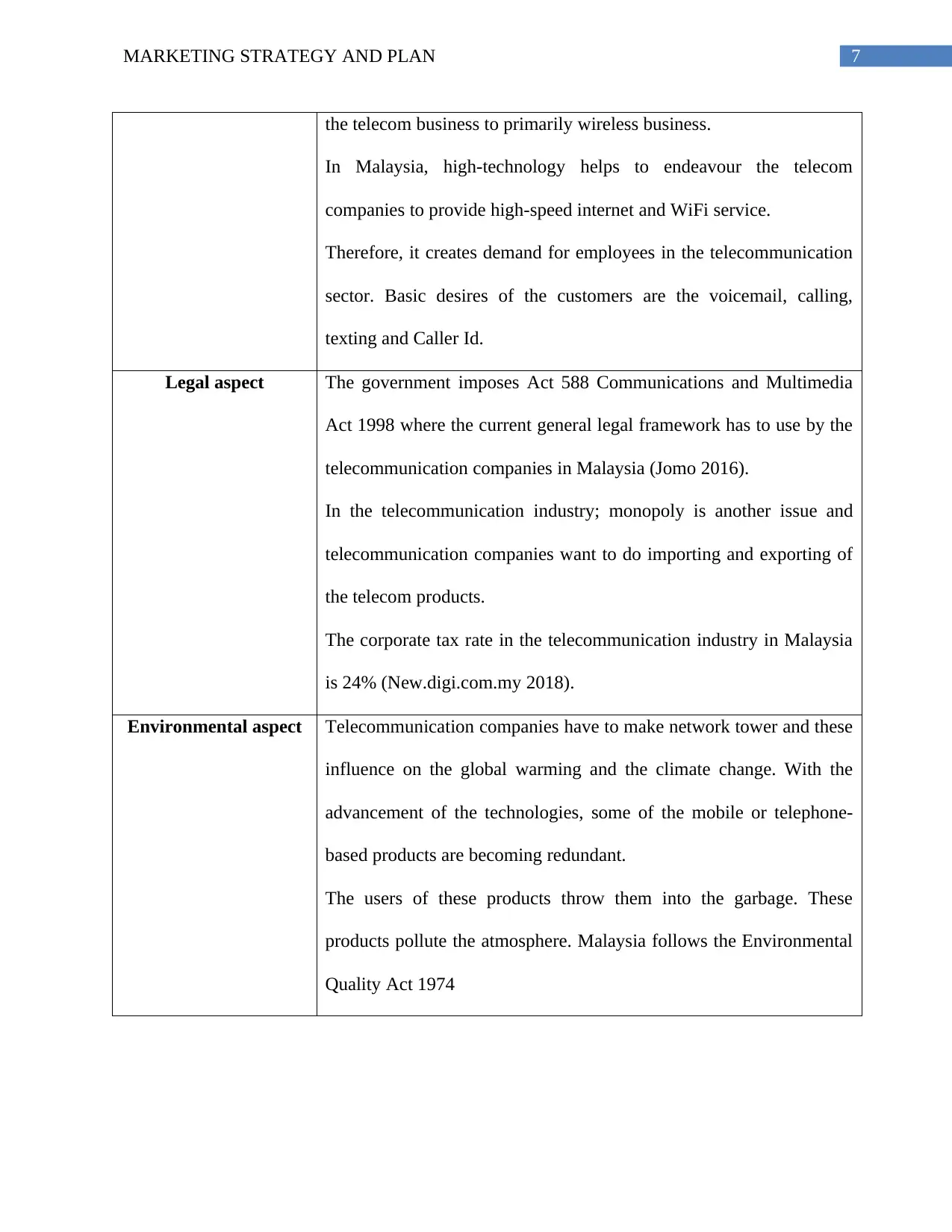
7MARKETING STRATEGY AND PLAN
the telecom business to primarily wireless business.
In Malaysia, high-technology helps to endeavour the telecom
companies to provide high-speed internet and WiFi service.
Therefore, it creates demand for employees in the telecommunication
sector. Basic desires of the customers are the voicemail, calling,
texting and Caller Id.
Legal aspect The government imposes Act 588 Communications and Multimedia
Act 1998 where the current general legal framework has to use by the
telecommunication companies in Malaysia (Jomo 2016).
In the telecommunication industry; monopoly is another issue and
telecommunication companies want to do importing and exporting of
the telecom products.
The corporate tax rate in the telecommunication industry in Malaysia
is 24% (New.digi.com.my 2018).
Environmental aspect Telecommunication companies have to make network tower and these
influence on the global warming and the climate change. With the
advancement of the technologies, some of the mobile or telephone-
based products are becoming redundant.
The users of these products throw them into the garbage. These
products pollute the atmosphere. Malaysia follows the Environmental
Quality Act 1974
the telecom business to primarily wireless business.
In Malaysia, high-technology helps to endeavour the telecom
companies to provide high-speed internet and WiFi service.
Therefore, it creates demand for employees in the telecommunication
sector. Basic desires of the customers are the voicemail, calling,
texting and Caller Id.
Legal aspect The government imposes Act 588 Communications and Multimedia
Act 1998 where the current general legal framework has to use by the
telecommunication companies in Malaysia (Jomo 2016).
In the telecommunication industry; monopoly is another issue and
telecommunication companies want to do importing and exporting of
the telecom products.
The corporate tax rate in the telecommunication industry in Malaysia
is 24% (New.digi.com.my 2018).
Environmental aspect Telecommunication companies have to make network tower and these
influence on the global warming and the climate change. With the
advancement of the technologies, some of the mobile or telephone-
based products are becoming redundant.
The users of these products throw them into the garbage. These
products pollute the atmosphere. Malaysia follows the Environmental
Quality Act 1974
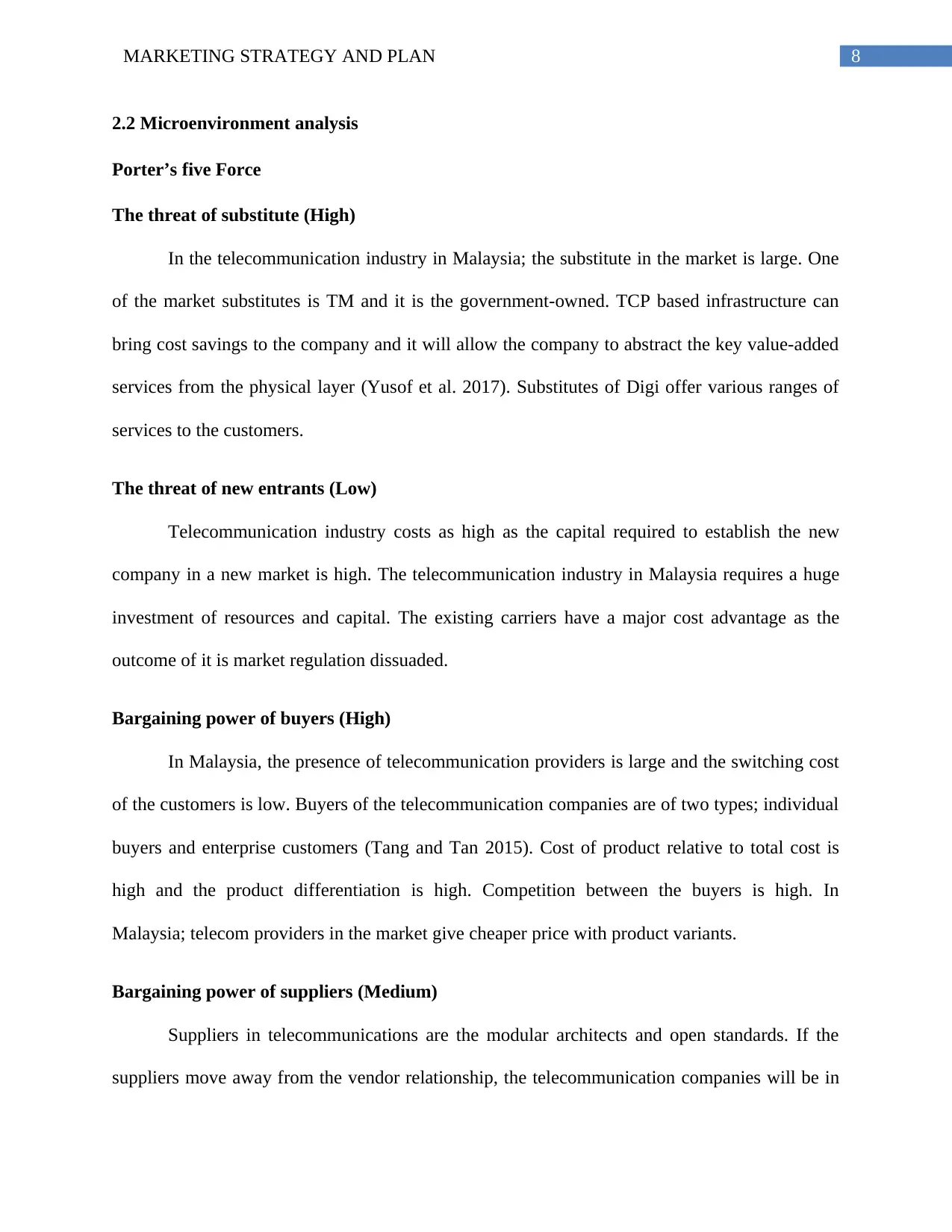
8MARKETING STRATEGY AND PLAN
2.2 Microenvironment analysis
Porter’s five Force
The threat of substitute (High)
In the telecommunication industry in Malaysia; the substitute in the market is large. One
of the market substitutes is TM and it is the government-owned. TCP based infrastructure can
bring cost savings to the company and it will allow the company to abstract the key value-added
services from the physical layer (Yusof et al. 2017). Substitutes of Digi offer various ranges of
services to the customers.
The threat of new entrants (Low)
Telecommunication industry costs as high as the capital required to establish the new
company in a new market is high. The telecommunication industry in Malaysia requires a huge
investment of resources and capital. The existing carriers have a major cost advantage as the
outcome of it is market regulation dissuaded.
Bargaining power of buyers (High)
In Malaysia, the presence of telecommunication providers is large and the switching cost
of the customers is low. Buyers of the telecommunication companies are of two types; individual
buyers and enterprise customers (Tang and Tan 2015). Cost of product relative to total cost is
high and the product differentiation is high. Competition between the buyers is high. In
Malaysia; telecom providers in the market give cheaper price with product variants.
Bargaining power of suppliers (Medium)
Suppliers in telecommunications are the modular architects and open standards. If the
suppliers move away from the vendor relationship, the telecommunication companies will be in
2.2 Microenvironment analysis
Porter’s five Force
The threat of substitute (High)
In the telecommunication industry in Malaysia; the substitute in the market is large. One
of the market substitutes is TM and it is the government-owned. TCP based infrastructure can
bring cost savings to the company and it will allow the company to abstract the key value-added
services from the physical layer (Yusof et al. 2017). Substitutes of Digi offer various ranges of
services to the customers.
The threat of new entrants (Low)
Telecommunication industry costs as high as the capital required to establish the new
company in a new market is high. The telecommunication industry in Malaysia requires a huge
investment of resources and capital. The existing carriers have a major cost advantage as the
outcome of it is market regulation dissuaded.
Bargaining power of buyers (High)
In Malaysia, the presence of telecommunication providers is large and the switching cost
of the customers is low. Buyers of the telecommunication companies are of two types; individual
buyers and enterprise customers (Tang and Tan 2015). Cost of product relative to total cost is
high and the product differentiation is high. Competition between the buyers is high. In
Malaysia; telecom providers in the market give cheaper price with product variants.
Bargaining power of suppliers (Medium)
Suppliers in telecommunications are the modular architects and open standards. If the
suppliers move away from the vendor relationship, the telecommunication companies will be in
⊘ This is a preview!⊘
Do you want full access?
Subscribe today to unlock all pages.

Trusted by 1+ million students worldwide

9MARKETING STRATEGY AND PLAN
trouble. The switching cost of the suppliers is heavy for the Malaysian telecommunication
companies.
Competitive rivalry: (High)
In Malaysia; competitive rivalry in telecommunication is high as in Malaysia; Telecom
Malaysia, Celcom, Maxis Communications and Digi Telecom are the major players. Competition
among these companies is high as the people have options to switch to any other provider at any
time.
Telecom Providers in Malaysia Market share
Digi 28%
Maxis 25%
Celcom Axiata 25%
MVNOs 12%
U Mobile 10%
Table1: Telecom service providers market share in Malaysia
(Source: Analysismason.com 2018)
Above table shows the information that Digi is the market leader in the competition having the
highest market share in Malaysia in telecommunication.
2.3 Internal environment
Mission
The dedication of the team is the key approach to deliver the work process with integrity
and accountability in telecommunication solution in Malaysia.
trouble. The switching cost of the suppliers is heavy for the Malaysian telecommunication
companies.
Competitive rivalry: (High)
In Malaysia; competitive rivalry in telecommunication is high as in Malaysia; Telecom
Malaysia, Celcom, Maxis Communications and Digi Telecom are the major players. Competition
among these companies is high as the people have options to switch to any other provider at any
time.
Telecom Providers in Malaysia Market share
Digi 28%
Maxis 25%
Celcom Axiata 25%
MVNOs 12%
U Mobile 10%
Table1: Telecom service providers market share in Malaysia
(Source: Analysismason.com 2018)
Above table shows the information that Digi is the market leader in the competition having the
highest market share in Malaysia in telecommunication.
2.3 Internal environment
Mission
The dedication of the team is the key approach to deliver the work process with integrity
and accountability in telecommunication solution in Malaysia.
Paraphrase This Document
Need a fresh take? Get an instant paraphrase of this document with our AI Paraphraser

10MARKETING STRATEGY AND PLAN
Vision
Signify the opportunities and maintain a good relationship with employees to inspire
them and make the best place of work in Malaysia.
Culture and Strategy
Four major strategies are there for the development of the organisation and due to the
development, most of the telecommunication companies are lagging behind that. The future-
forward actions are important in that case and it grows and outpaces data-centric digital world.
For keep going the industry ahead of engagement with the customers is important and relevant
for the effective nature of the company (Faziharudean and Li-Ly 2011). To become the
customers' favourite partner and being the most efficient operator in Malaysia, the company has
made the position in between. This will provide them with enough boost and confidence to work
more and get the gel with employees and customers for the development of the organisation. The
employees of the organisation are practising responsible business conduct and the conduct will
find them enough boost for the development of the business to interact with customers in a
proper manner and try to understand what they need. Lastly, they maintain a good team and they
have some good leaders too for the management of the team. The team building and working
together is important and that deliver enough opportunity for the company to engage good social
relation in that case.
Mckinsey 7S strategy
The strategy based on the 7 different aspects of business like structure, system, strategy,
skill, staffing, and style and all these aspects are trying to maintain the core process of shared
values. In the case of Digi communication, innovate and evolvement of the product is important
and most profitable growth can be achieved through the process (Osman et al., 2011). The
Vision
Signify the opportunities and maintain a good relationship with employees to inspire
them and make the best place of work in Malaysia.
Culture and Strategy
Four major strategies are there for the development of the organisation and due to the
development, most of the telecommunication companies are lagging behind that. The future-
forward actions are important in that case and it grows and outpaces data-centric digital world.
For keep going the industry ahead of engagement with the customers is important and relevant
for the effective nature of the company (Faziharudean and Li-Ly 2011). To become the
customers' favourite partner and being the most efficient operator in Malaysia, the company has
made the position in between. This will provide them with enough boost and confidence to work
more and get the gel with employees and customers for the development of the organisation. The
employees of the organisation are practising responsible business conduct and the conduct will
find them enough boost for the development of the business to interact with customers in a
proper manner and try to understand what they need. Lastly, they maintain a good team and they
have some good leaders too for the management of the team. The team building and working
together is important and that deliver enough opportunity for the company to engage good social
relation in that case.
Mckinsey 7S strategy
The strategy based on the 7 different aspects of business like structure, system, strategy,
skill, staffing, and style and all these aspects are trying to maintain the core process of shared
values. In the case of Digi communication, innovate and evolvement of the product is important
and most profitable growth can be achieved through the process (Osman et al., 2011). The
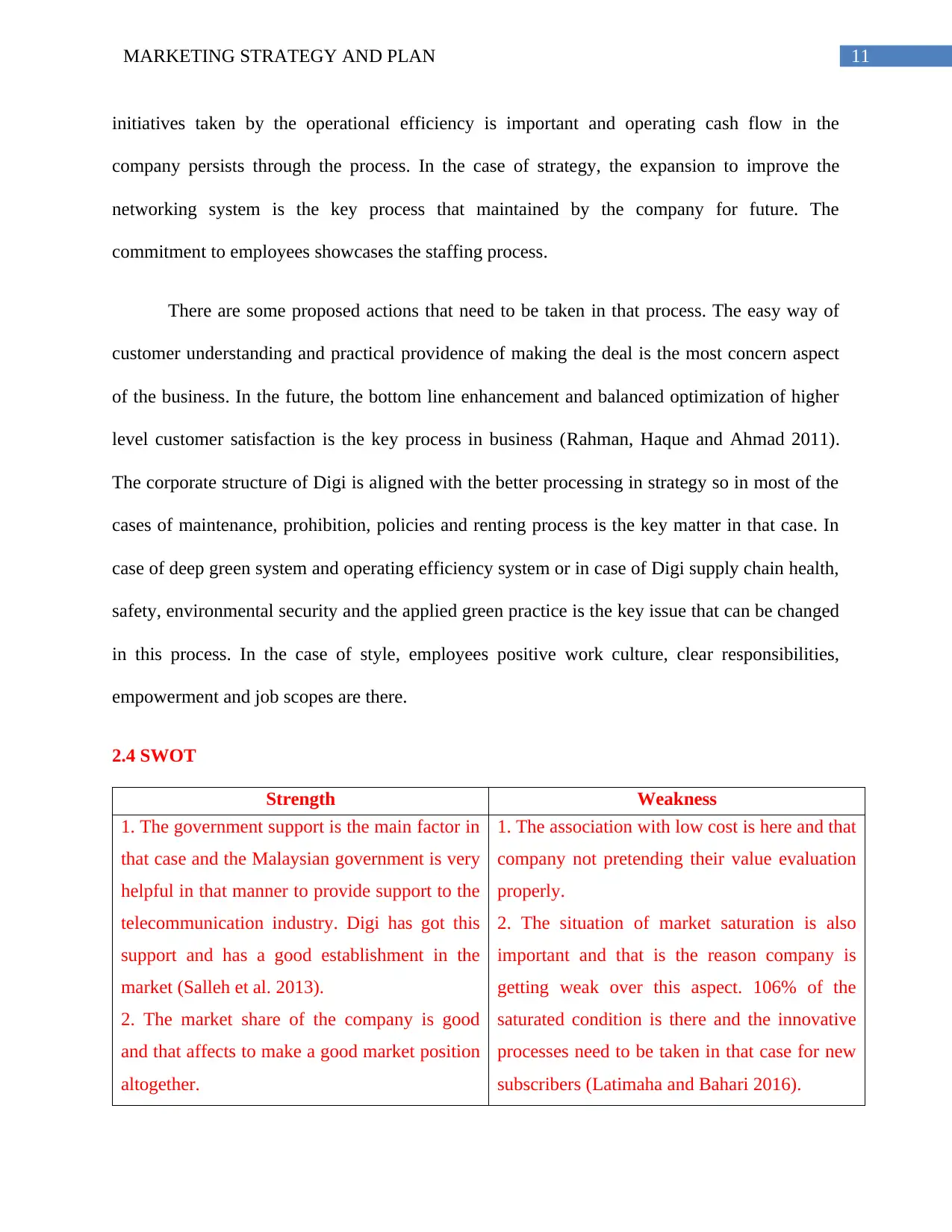
11MARKETING STRATEGY AND PLAN
initiatives taken by the operational efficiency is important and operating cash flow in the
company persists through the process. In the case of strategy, the expansion to improve the
networking system is the key process that maintained by the company for future. The
commitment to employees showcases the staffing process.
There are some proposed actions that need to be taken in that process. The easy way of
customer understanding and practical providence of making the deal is the most concern aspect
of the business. In the future, the bottom line enhancement and balanced optimization of higher
level customer satisfaction is the key process in business (Rahman, Haque and Ahmad 2011).
The corporate structure of Digi is aligned with the better processing in strategy so in most of the
cases of maintenance, prohibition, policies and renting process is the key matter in that case. In
case of deep green system and operating efficiency system or in case of Digi supply chain health,
safety, environmental security and the applied green practice is the key issue that can be changed
in this process. In the case of style, employees positive work culture, clear responsibilities,
empowerment and job scopes are there.
2.4 SWOT
Strength Weakness
1. The government support is the main factor in
that case and the Malaysian government is very
helpful in that manner to provide support to the
telecommunication industry. Digi has got this
support and has a good establishment in the
market (Salleh et al. 2013).
2. The market share of the company is good
and that affects to make a good market position
altogether.
1. The association with low cost is here and that
company not pretending their value evaluation
properly.
2. The situation of market saturation is also
important and that is the reason company is
getting weak over this aspect. 106% of the
saturated condition is there and the innovative
processes need to be taken in that case for new
subscribers (Latimaha and Bahari 2016).
initiatives taken by the operational efficiency is important and operating cash flow in the
company persists through the process. In the case of strategy, the expansion to improve the
networking system is the key process that maintained by the company for future. The
commitment to employees showcases the staffing process.
There are some proposed actions that need to be taken in that process. The easy way of
customer understanding and practical providence of making the deal is the most concern aspect
of the business. In the future, the bottom line enhancement and balanced optimization of higher
level customer satisfaction is the key process in business (Rahman, Haque and Ahmad 2011).
The corporate structure of Digi is aligned with the better processing in strategy so in most of the
cases of maintenance, prohibition, policies and renting process is the key matter in that case. In
case of deep green system and operating efficiency system or in case of Digi supply chain health,
safety, environmental security and the applied green practice is the key issue that can be changed
in this process. In the case of style, employees positive work culture, clear responsibilities,
empowerment and job scopes are there.
2.4 SWOT
Strength Weakness
1. The government support is the main factor in
that case and the Malaysian government is very
helpful in that manner to provide support to the
telecommunication industry. Digi has got this
support and has a good establishment in the
market (Salleh et al. 2013).
2. The market share of the company is good
and that affects to make a good market position
altogether.
1. The association with low cost is here and that
company not pretending their value evaluation
properly.
2. The situation of market saturation is also
important and that is the reason company is
getting weak over this aspect. 106% of the
saturated condition is there and the innovative
processes need to be taken in that case for new
subscribers (Latimaha and Bahari 2016).
⊘ This is a preview!⊘
Do you want full access?
Subscribe today to unlock all pages.

Trusted by 1+ million students worldwide
1 out of 29
Related Documents
Your All-in-One AI-Powered Toolkit for Academic Success.
+13062052269
info@desklib.com
Available 24*7 on WhatsApp / Email
![[object Object]](/_next/static/media/star-bottom.7253800d.svg)
Unlock your academic potential
Copyright © 2020–2026 A2Z Services. All Rights Reserved. Developed and managed by ZUCOL.





